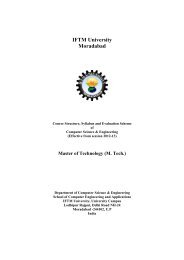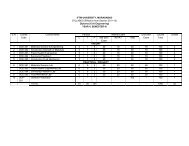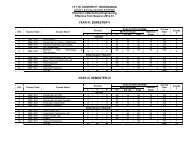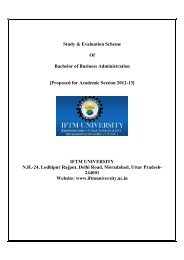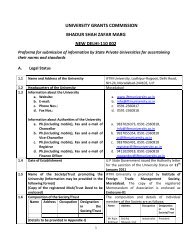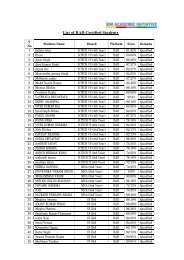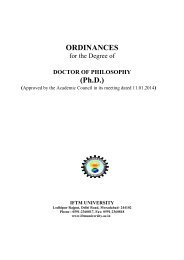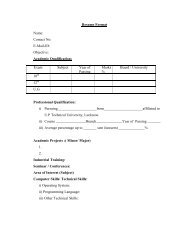Download - IFTM University
Download - IFTM University
Download - IFTM University
Create successful ePaper yourself
Turn your PDF publications into a flip-book with our unique Google optimized e-Paper software.
<strong>IFTM</strong> UNIVERSITY, MORADABADSTUDY & EVALUATION SCHEMEDiploma in PharmacyYEAR-IISl.No.SubjectCodeSubject NamePeriodsL T PTHEORYEvaluation SchemeMid SessionalExamn.CT As At TotalAnnualExamn.SubjectsTotal1. DPH=201 Pharmaceutics-II 3 -- 0 15 -- 05 20 80 100 32. DPH-2023. DPH-2034. DPH-2045. DPH-2056. DPH-206PharmaceuticalChemistry-IIPharmacology &ToxicologyPharmaceuticalJurisprudenceDrug Store & BusinessManagementHospital & ClinicalPharmacyCredits3 -- 0 15 -- 05 20 80 100 33 -- 0 15 -- 05 20 80 100 32 -- 0 15 -- 05 20 80 100 23 -- 0 15 -- 05 20 80 100 33 -- 0 15 -- 05 20 80 100 3PRACTICAL/PROJECT7. DPH=201P Pharmaceutics-II 0 0 4 -- 10 10 20 80 100 28. DPH-202P9. DPH-203P10. DPH-206PPharmaceuticalChemistry-IIPharmacology &ToxicologyHospital & ClinicalPharmacy0 0 3 -- 10 10 20 80 100 20 0 3 -- 10 10 20 80 100 20 0 3 -- 10 10 20 80 100 2Total 17 -- 13 -- -- -- -- -- 1000 25L: Lecture; T: Tutorial; P: Practical; CT: Class Test; As: Assignment; At: Attendance.
DIPLOMA IN PHARMACY (IInd Year)DPH-201PHARMACEUTICS II1. Dispensing Pharmacy:(i)Prescriptions-Reading and understanding of prescription; Latin terms commonly used(Detailed study is not necessary), Modern methods of prescribing, adoption of metric system.Calculations involved in dispensing.(ii)Incompatibilities in Prescriptions-Study of various types of incompatibilities-physical,chemical and therapeutic.(iii) Posology. Dose and Dosage of drugs, Factors influencing dose, Calculations of doseson the basis of age, sex and surface area. Veterinary doses.2. Dispensed Medications:(Note: A detailed study of the following dispensed medication is necessary. Methods ofpreparation with theoretical and practical aspects, use of appropriate containers and closures.Special labelling requirements and storage conditions should be high-lighted).(i)Powders-Types of powders-Advantages and disadvantages of powders, Granules,Cachets and Tablet triturates. Preparation of different types of powders encountered inprescriptions. Weighing methods, possible errors in weighing, minimum weighable amountsand weighing of material below the minimum weighable amount, geometric dilution andproper usage and care of dispensing balance.(ii)Liquid Oral Dosage Forms:(a). Monophasic. Theoretical aspects including commonly used vehicles, essential adjuvantlike stabilizers, colourants and flavours, with examples.Review of the following monophasic liquids with details of formulation and practicalmethods.Liquids for internal administrationLiquids for external administration or usedon mucus membranes.Mixtures and concentratesSyrupsElixirsGarglesMouth washesThroat-paintsDouchesEar DropsNasal drops & Sprays LinimentsLotions.
(b) Biphasic Liquid Dosage Forms:(i) Suspension (elementary study)----Suspensions containing diffusible solids and liquidsand their preparations. Study of the adjuvants used like thickening agents, wetting agents,their necessity and quantity to be incorporated. Suspensions of precipitate forming liquidslike, tinctures, their preparations and stability. Suspensions produced by chemical reaction.An introduction to flocculated, non-flocculated suspension system.(ii) Emulsions-Types of emulsions, identification of emulsion system, formulation ofemulsions, selection of emulsifying agents. Instabilities in emulsions. Preservation ofemulsions.(iii) Semi-Solid Dosage Forms:(a) Ointments. Types of ointments, classification and selection of dermatological vehicles.Preparation and stability of ointments by the following processes:(i) Trituration (ii) Fusion (iii) Chemical reaction (iv) Emulsification.(b) Pastes--- Difference between ointments and pastes, bases of pastes. Preparation ofpastes and their preservation.(c) Jellies-An introduction to the different types of jellies and their preparation.(d) An elementary study of poultice.(e) Suppositories and pessaries-Their relative merits and demerits, types of suppositories,suppository bases, classification, properties, Preparation and packing of suppositories. Use ofsuppositories for drug absorption.(iv) Dental and Cosmetic Preparations:Introduction to Dentrifices, Facial cosmetics, Deodorants, Antiperspirants, Shampoos, Hairdressing and Hair removers.(v) Sterile Dosage Forms:(a) Parenteral dosage forms. Definitions, General requirements for parenteral dosageforms. Types of parenteral formulations, vehicles, adjuvants, processing, personnel, facilitiesand Quality control. Preparation of Intravenous fluids and admixtures-Total parenteralnutrition, Dialysis fluids.(b) Sterility testing, Particulate matter monitoring-Faulty seal packaging.(c) Ophthalmic Products-Study of essential characteristics of different ophthalmicpreparations. Formulation additives, special precautions in handling and storage ofophthalmic products.
DPH-201PPHARMACEUTICS II (Practical)Dispensing of at least 100 products covering a wide range of preparations such as mixtures,emulsions, lotions, liniments, E.N.T, preparations, ointments, suppositories, powders,incompatible prescriptions etc.Books recommended :(Latest editions)1. Indian Pharmacopoeia.2. British Pharmacopoeia.3. National Formularies (N.F.I, B.N.F)4. Remington's Pharmaceutical Sciences.5. Martindale Extra Pharmacopoeia.
DPH-202PHARMACEUTICAL CHEMISTY II1. Introduction to the nomenclature of organic chemical systems with particular reference toheterocyclic system containing up to 3 rings.2. The Chemistry of following Pharmaceutical organic compounds, covering theirnomenclature, chemical structure, uses and the important Physical and Chemical properties(Chemical structure of only those compounds marked with asterisk (*).The stability and storage conditions and the different type of Pharmaceutical formulations ofthese drugs and their popular brand names.Antiseptics and Disinfectants-Proflavine, * Benzalkoniumchloride, Cetrimide, Chlorocresol*,Chloroxylene, Formaldehyde solution, Hexachlorophene, Liquified phenol, Nitrofurantoin.Sulfonamides-Sulfadiazine, Sulfaguanidine*, Phthalysulfathiazole, Succinylsulfathiazole,Sulfadimethoxine, Sulfamethoxypridazine, Sulfamethoxazole, co-trimoxazole,Sulfacetamide*.Antileprotic Drugs-Clofazimine, Thiambutosine, Dapsone*, Solapsone.Anti-tubercular Drugs-Isoniazid*, PAS*, Streptomycin, Rifampicin, Ethambutol*,Thiacetazone, Ethionamide, Cycloserine, Pyrazinamide*.Antiamoebic and Anthelmintic Drugs- Emetine, Metronidazole*, Halogenatedhydroxyquinolines, diloxanidefuroate, Paramomycin Piperazine*, Mebendazole, D.E.C*,.Antibiotics-Benzyl Penicillin*, Phenoxy methyl Penicillin*, Benzathine PenicillinAmpicillin*, Cloxacillin, Carbenicillin, Gentamicin, Neomycin , Erythromycin ,Tetracycline, Cephalexin, Cephaloridine , Cephalothin, Griseofulvin , Chloramphenicol.Antifungal agents-Undecylenic acid, Tolnaftate, Nystatin, Amphotericin, Hamycin.Antimalarial Drugs-Chloroquine*, Amodiaquine, Primaquine, Proguanil, Pyrimethamine*,Quinine, Trimethoprim.Tranquilizers-Chlorpromazine*, Prochlorperazine, TrifluoPerazine, Thiothixene,Haloperidol*, Triperidol, Oxypertine, Chlordiazepoxide, Diazepam*, Lorazepam,Meprobamate.Hypnotics—Phenobarbitone*, Butobarbitone, Cyclobarbitone, Nitrazepam, Glutethimide*,Methyprylone, Paraldehyde, Triclofos sodium.General Anaesthetics-Halothane*, Cyclopropane*, Diethyl ether*, Methohexital sodium,Thiopental sodium, Trichloroethyelene.Antidepressant Drugs—Amitriptyline, Nortryptyline, Imipramine*, Phenelzine,Tranylcypromine.Analeptics-Theophylline, Caffeine*,Coramine*, Dextroamphetamine.
Adrenergic Drugs-Adrenaline*, Noradrenaline, Isoprenaline*, Phenylephrine Salbutamol,Terbutaline, Ephedrine *, Pseudoephedrine.Adrenergic Antagoinst-Tolazoline, Propranolol*, Practolol.Cholinergic Drugs-Neostigmine*,Pyridostigmine, Pralidoxime, Pilocarpine, Physostigmine*.Cholinergic Antagonists-Atropine*, Hysocine, Homatropine, Propantheline*, Benztrophine,Tropicamide, Biperiden.*Diuretic Drugs-Furosemide*,Chlorothiazide, Hydrochlorothaizide*, Benzthiazide,Urea*,Mannitol *, Ethacrynic Acid.Cardiovascular Drugs-Ethyl nitrite*, Glyceryl trinitrate, Alpha methyl dopa, Guanethidine,Clofibrate, Quinidine.Hypoglycemic Agents-Insulin, Chlorpropamide*, Tolbutamide, Glibenclamide, Phenformin*, Metformin.Coagulants and Anti-Coagulants-Heparin, Thrombin, Menadione*, Bishydroxycoumarin,Warfarin Sodium.Local Anaesthetics-Lignocaine*, Procaine*, Benzocaine.Histamine and Anti–histaminic Agents-Histamine, Diphenhydramine*, Promethazine,Cyproheptadine, Mepyramine, Pheniramine, Chlorpheniramine*.Analgesics and Anti-pyretics–Morphin, Pethidine*, Codeine, Methadone, Aspirin*,Paracetamol*, Analgin, Dextropropoxyphene, Pentazocine.Non-steroidal anti-inflammatory Agents-Indomethacin*, phenylbutazone*,Oxyphenbutazone, Ibuprofen, Thyroxine and Antithyroids-Thyroxine*, Methimazole,Methylthiouracil, Propylthiouracil.Diagnostic Agents-Iopanoic Acid, Propyliodone, Sulfobromophthalein. Sodiumindigotindisulfonate, Indigo Carmine, Evans blue, Congo Red, Fluorescein Sodium .*Anticonvulsants, cardiac glycosides, Antiarrhythmic antihypertensives & vitamins.Steroidal Drugs-Betamethazone, Cortisone, Hydrocortisone, prednisolone, Progesterone,Testosterone, Oestradiol, Nandrolone.Anti- Neoplastic Drugs-Actinomycins, Azathioprine, Busulphan, Chlorambucil, Cisplatincyclophosphamide, Daunorubicin hydrochloride, Fluorouracil, Mercaptopurine,Methotrexate, Mytomycin.Books Recommended :(Latest editions)1. Pharmocopoeia of India.2. British Pharmaceutical Codex.3. Martindale: The Extra Pharmacopoeia.
DPH-202PPHARMACEUTICAL CHEMISTRY-II (Practical)1. Systematic qualitative testing of organic drugs involving Solubility determination, meltingpoint and boiling point, detection of elements and functional groups (10 compounds).2. Official identification test for certain groups of drugs included in the I.P like barbiturates,sulfonamides, phenothiazine, Antibiotic etc (8 compounds).3. Preparation of three simple organic preparations.
DPH-203PHARMACOLOGY & TOXICOLOGY1. Introduction to Pharmacology, scope of Pharmacology.2. Routes of administration of drugs, their advantages and disadvantages.3. Various processes of absorption of drugs and the factors affecting them, Metabolism,distribution and excretion of drugs.4. General mechanism of drugs action and the factors which modify drug action.5. Pharmacological classification of drugs. The discussion of drugs should emphasise thefollowing aspect:(i)Drugs acting on the Central Nervous System:(a) General anaesthetics, adjunction to anaesthesia, intravenuous anasesthetics.(b) Analgesic antipyretics and non-steroidal anti-inflammatory drugs, Narcotic analgesics,Antirheumatic and antigout remedies, Sedatives and Hypnotics, Psychopharmacologicalagents, anti convulsants, analeptics.(c) Centrally acting muscle relaxants and anti parkinsonism agents(ii) Local anaesthetics.(iii) Drug acting on autonomic nervous system.(a) Cholinergic drug, Anticholinergic drugs, anti cholinesterase drugs.(b) Adrenergic drugs and adrenergic recepter blockers.(c) Neurones blockers and ganglion blockers.(d) Neuromuscular blockers, drugs used in myasthenia gravis.(iv) Drugs acting on eye, mydriatics, drugs used in glaucoma.(v) Drugs acting on respiratory system-Respiratory stimulants, Bronchodilators, Nasaldecongestants, Expectorants and Antitussive agents.(vi)Antacids, Physiological role of histamine and serotonin, Histamine and Antihistamines,Prostaglandins.(vii) Cardio Vascular drugs, Cardiotonics, Antiarrhythmic agents, Antianginal agents,Antihypertensive agents, Peripheral Vasodilators and drugs used in atherosclerosis.(viii) Drugs acting on the blood and blood forming organs. Haematinics, Coagulants and antiCoagulants, Haemostatics, Blood substitutes and plasma expanders.(ix) Drugs affecting renal function-Diuretics and antidiuretics.(x) Hormones and hormone antagonists-hypoglycemic agents, Antithyroid drugs, sexhormones and oral contraceptives, corticosteroids.
(xi) Drugs acting on digestive system-Carminatives, digestants Bitters, Antacids and drugsused in Peptic ulcer, purgatives, and laxatives, Antidiarrhoeals, Emetics, Antiemetics, Antispasmodics.Chemotherapy of microbial disease ;Urinary antiseptics, Sulphonamides, Penicillins,Streptomycin, Tetracylines and other antibiotics, Antitubercular agents, Antifungal agents,antiviral drugs, antileprotic drugs.6. Chemotherapy of protozoal diseases Anthelmintic drugs.7. Chemotherapy of cancer.8. Disinfectants and antiseptics.A detailed study of the action of drugs on each organ is not necessary.DPH-203PPHARMACOLOGY (Practical)The first six of the following experiments will be done by the students while the remainingwill be demonstrated by the teacher.1. Effect of K+, Ca++, acetylcholine and adrenaline on frog's heart.2. Effect of acetylcholine on rectus abdominis muscle of Frog and guinea pig ileum.3. Effect on spasmogens and relaxants on rabbits intestine.4. Effect of local anaesthetics on rabbit cornea.5. Effect of mydriatics and miotics on rabbits eye.6. To study the action of strychnine on frog.7. Effect of digitalis on frog's heart.8. Effect of hypnotics in mice.9. Effect of convulsants and anticonvulsant in mice or rats.10. Test for pyrogen.11. Taming and hypnosis potentiating effect of chlorpromazine in mice/rats.12. Effect of diphenhydramine in experimentally produced asthma in guinea pigs.
DPH-204PHARMACEUTICAL JURISPRUDENCE1. Origin and nature of Pharmaceutical legislation in India, its scope and objectives.Evolution of the "Concept of Pharmacy" as an integral part of the Health Care System.2. Principles and significance of Professional Ethics. Critical study of the code ofPharmaceutical Ethics drafted by Pharmacy Council of India.3. Pharmacy Act, 1948-The General study of the Pharmacy Act with special reference toEducation Regulations, working of State and Central Councils, constitution of these councilsand functions, Registration procedures under the Act.4. The Drugs and Cosmetics Act, 1940—General study of the Drugs and Cosmetics Act andthe Rules thereunder. Definitions and salient features related to retail and wholesaledistribution of drugs. The powers of Inspectors, the sampling procedures and the procedureand formalities in obtaining licences under the rule. Facilities to be provided for running aPharmacy effectively. General study of the Schedules with special reference of schedules C,C1, F, G, J, H, P and X and salient features of labelling and storage condition of drugs.5. The Drug and Magic Remedies (Objectionable Advertisement) Act, 1945-General study ofthe Act Objectives, special reference to be laid on Advertisements. Magic remedies andobjectionable and permitted advertisements-disease which cannot be claimed to be cured.6. Narcotic Drugs and Psychotropic Substances Act, 1985-A brief study of the act withspecial reference to its objectives, offences and punishment.7. Brief introduction to the study of the following acts.1. Latest Drugs (Price Control) Order in force.2. Poisons Act 1919 (as amended to date)3. Medicinal and Toilet Preparations (Excise Duties) Act, 1995 (as amended to date)4. Medical Termination of Pregnancy Act, 1971 (as amended to date)BOOKS RECOMMENDED (Latest edition)Bare Acts of the said laws published by Government.
DPH-205DRUG STORE AND BUSINESS MANAGEMENTPart-I Commerce1. Introduction-Trade, Industry and Commerce, Functions and subdivision of Commerce,Introduction of Elements of Economics and Management.2. Forms of Business Organisations.3. Channels of Distribution.4. Drug House Management-Selection of Site, Space Lay-out and legal requirements.Importance and objectives of Purchasing, selection of suppliers, credit information, tenders,contracts and price determination and legal requirements thereto.Codification, handling of drug stores and other hospital supplies.5. Inventory Control-objects and importance, modern techniques like ABC, VED analysis,the lead time, inventory carrying cost, safety stock, minimum and maximum stock levels,economic order quantity, scrap and surplus disposal.6. Sales Promotion, Market Research, Salesmanship, qualities of a salesman, Advertising andWindow Display.7. Recruitment, training, evaluation and compensation of the pharmacist.8 Banking and Finance Service and functions of the bank, Finance Planning and sources offinance.Part-II Accountancy1. Introduction to the accounting concepts and conventions, Double entry Book keeping,Different kinds of accounts.2. Cash Book.3. General Leger and Trial Balance.4. Profit and Loss Account and Balance Sheet.5. Simple technique of analysing financial statements.Introduction to Budgetting.Books Recommended (Latest edition)Remington's Pharmaceutical Sciences.
DPH-206HOSPITAL AND CLINICAL PHARMACYPart-I Hospital Pharmacy1. Hospitals Definition, Function, Classifications based on various criteria, organisation,Management and Health delivery system in India.2. Hospital Pharmacy:(a) Definition(b) Functions and objectives of Hospital Pharmaceutical services.(c) Location, Layout, Flow chart of material and men.(d) Personnel and facilities requirements including equipments based on individual andbasic needs.(e) Requirements and abilities required for Hospital pharmacists.3. Drug Distribution system in Hospitals:(a) Out-patient services(b) In-patient services-(a) types of services (b) detailed discussion of unit Dose system,Floor ward stock system, Satellite pharmacy services, Central sterile services, Bed SidePharmacy.4. Manufacturing:(a) Economical considerations, estimation of demand.(b) Sterile manufacture-large and small volume parenterals, facilities, requirements, layoutproduction planning, man-power requirements.(c) Non-sterile manufacture-Liquid orals, externals-bulk concentrates.(d) Procurement of stores and testing of raw materials.5. Nomenclature and uses of surgical instruments and Hospital Equipments and healthaccessories.6. P.T.C (Pharmacy Therapeutic Committee), Hospital Formulary System and theirorganisation, functioning, composition.7. Drug Information service and Drug Information Bulletin.8. Surgical dressing like cotton, gauze, bandages and adhesive tapes including theirpharmacopoeial tests for quality. Other hospital supply e.g I.V sets B.G sets, Ryals tubes,Catheters, Syringes etc.
9. Application of computer in maintenance of records, inventory control, medicationmonitoring, drug information and data storage and retrieval in hospital and retail pharmacyestablishments.Part-II Clinical Pharmacy1. Introduction to Clinical Pharmacy Practice-Definition, scope.2. Modern dispensing aspects-Pharmacists and Patient counselling and advice for the use ofcommon drugs, medication history.3. Common daily terminology used in the Practice of Medicine.4. Disease, manifestation and pathophysiology including salient symptoms to understand thedisease like Tuberculosis, Hepatitis, Rheumatoid Arthritis, Cardiovascular diseases, Epilepsy,Diabetes, Peptic Ulcer, Hypertension.5. Physiological parameters with their significance.6. Drug Interactions:(a) Definition and introduction.(b) Mechanism of Drug Interaction.(c) Drug-drug interaction with reference to analgesics, diuretics, cardiovascular drugs,Gastro-intestinal agents, Vitamins and Hypoglycemic agents.(d) Drug-food interaction.7. Adverse Drug Reactions.:(a) Definition and Significance.(b) Drug-induced diseases and Teratogenicity.8. Drugs in Clinical Toxicity-Introduction, general treatment of poisoning, systematicantidotes. Treatment of insecticide poisoning, heavy metal poison, Narcotic drugs,Barbiturate, Organophosphours poisons.9. Drug dependences, Drug abuse, addictive drugs and their treatment, complications.10. Bio-availability of drugs, including factors affecting it.Books recommended (Latest editions)1. Remington's Pharmaceutical Sciences.2. Martindale: The Extra Pharmacopoeia



